
 |
|
#121
|
|||
|
|||
|
[QUOTE=joeguam;3388066]Please, I'm not sure I can allow you to say it's "your fault".
 Anyways, I think the best thing to do is for me to create a "Quick Start" or check list guide of my own that is specifically for this mix. It will also help the other musicians to set up the board properly. Would you mind if I put this together, post it here for you to look at and let me know if there are any changes I need to make? Thanks Bob! ... Joe, Let's wait and see if it's all working as hoped for, but by all means go ahead, once we're sure everything is A-OK. Let me know as soon as you've checked it out. I'm really anxious to hear what the result is.  Bob |
|
#122
|
|||
|
|||
|
Bob, I went at lunch today because I couldn't wait to test it out and I have some really promising news. Here are the steps I completed to test:
- Disabled the CONTOUR and the LOW CUT (HPF) on both speakers - Set the level of each speaker to LINE (9:00 Position) - Performed the normal reset of all controls on the mixer - Set the SUB ASSIGN 1 and SUB ASSIGN 2 to "U" #23. I used an iPhone dock speaker and played the Cantate youtube video to provide the "choir input", this provided a loud enough sound as detected by the input LED's 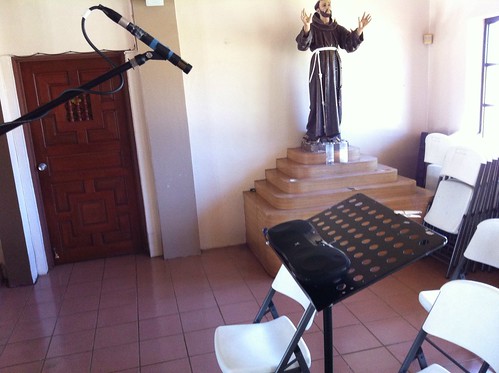 #24. Here's a photo of the mixer after all testing was completed, it will help to reference the next steps I took in the testing process: - Channel 1 is the choir condenser - Channel 7 is the clavinova - Channel 8 is the grand piano dynamic (For a real close up photo of the mixer which you can zoom in on click here: http://www.mackie.com/products/cfx12...12mkII-top.jpg) 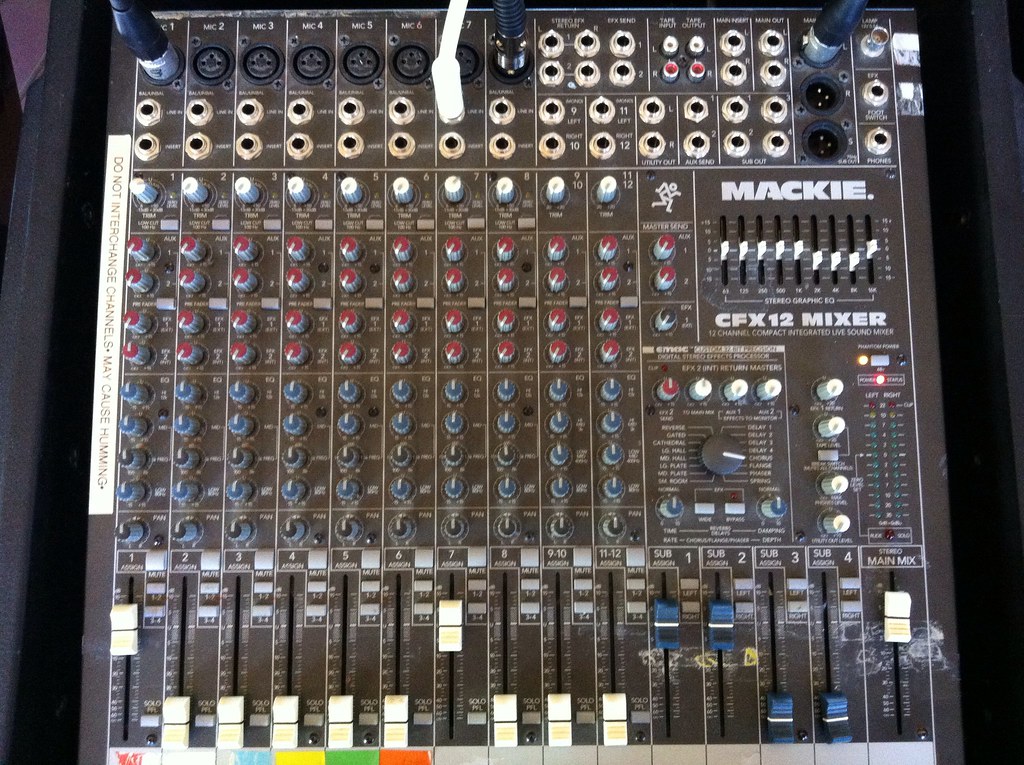 - While the iPhone dock speaker was playing the Cantate music, I kept channel 1 MUTED, engaged the SOLO button and set the channel fader to "U" - Next, I increased the TRIM (AKA. the gain) until the input LED's occasionally hit the ZERO LEVEL SET when the Cantate voices got loud - Then, I UNMUTED channel 1 - Next I slowly increased the MAIN MIX fader listening carefully for any feedback - I got all the way up to "U" without any feedback! At this point, the Cantate voices started to sing even louder about 3 minutes into the song, which started a very slow and slight feedback, so I pulled about -3 to -5 dB's off of the 2K, 4K and 8K GEQ knobs and this ceased the feedback almost immediately (thanks for this trick!) - Next, I slowly increased the EFX 2 SEND and TO MAIN MIX to "U" - Next, I slowly increased the EFX 2 internal effect knob of channel 1 to "U" to add some chorus to the Cantate voices in the mix - again, no feedback - At this point, I felt fairly comfortable that the levels of the mix were stable, so I restarted the Cantate song and walked to the back of the church and stood at each corner walking back and forth to listen carefully to the clarity of each part of the Cantate recording - the highs of the voices, the lows of the bass, the mids of the organ. - It did feel like it could be a little louder at the back, so I increased the main fader above "U" and started getting feedback at about +3dB. No worries here though because I'll be able to fine tune this once I have the complete setup with the choir and the piano or clavinova. - Next, I turned on the clavinova and leveled it the same way. Remember, the clavinova AUX OUT is a fixed level output so I just banged on the keys until the input LED's matched that of the Cantate voices to create an even mix. I'm not much of a piano player so I just banged on the keys to be sure that it didn't invoke additional problems to the choir condenser - and it didn't. Phew. So that was where the testing ended. My conclusion after setting the levels on the Mackie Speakers to LINE instead of NORMAL are: - Able to get a "good" and "clear" signal into the mixer without feedback - Able to get all the inputs into the mixer at an even level - Able to raise the level of the entire mix as a whole and consistently I only wish I had my fiance with me to test the grand piano dynamic, but that's okay, we have time for that and hopefully we can get it done during tomorrow's practice. We'll see. Please share your thoughts. I thought it was a great testing session and can't wait to get the choir in to practice! Hopefully this sounds like great progress. ... Joe |
|
#123
|
|||
|
|||
|
Bob,
I forgot to mention, the speakers have finally been mounted, here are the photos. They are mounted to the same post which they were placed in front of when they were on the stands. #25. Stage right Mackie SRM450 speaker by the tabernacle 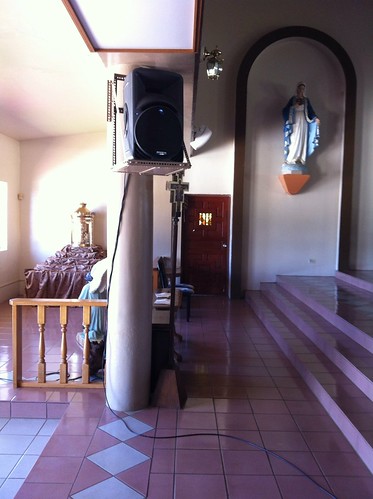 #26. Stage left Mackie SRM450 speaker by the choir  #27. Photo of the forward position of the lectern vs. the stage right Mackie 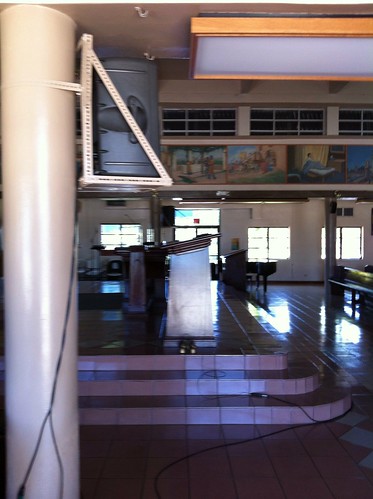 #28. Photo showing that I flipped the position of the lectern mic so that it is facing away from the mackie 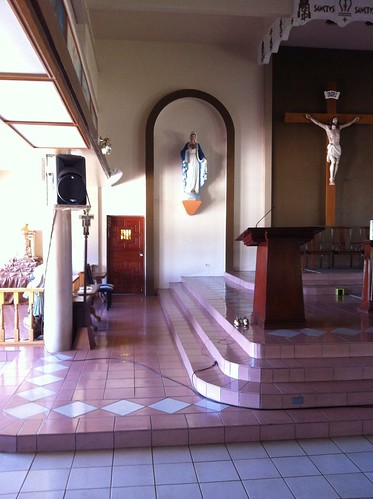 Let me know if you have any questions about these pictures. ... Joe |
|
#124
|
|||
|
|||
|
Sorry. Post deleted.
|
|
#125
|
|||
|
|||
|
Quote:
 Really appreciate the offer! Really appreciate the offer!... Joe |
|
#126
|
|||
|
|||
|
[QUOTE=joeguam;3388271]Bob, I went at lunch today because I couldn't wait to test it out and I have some really promising news. Here are the steps I completed to test:
- Disabled the CONTOUR and the LOW CUT (HPF) on both speakers - Set the level of each speaker to LINE (9:00 Position) - Performed the normal reset of all controls on the mixer - Set the SUB ASSIGN 1 and SUB ASSIGN 2 to "U" #23. I used an iPhone dock speaker and played the Cantate youtube video to provide the "choir input", this provided a loud enough sound as detected by the input LED's  #24. Here's a photo of the mixer after all testing was completed, it will help to reference the next steps I took in the testing process: - Channel 1 is the choir condenser - Channel 7 is the clavinova - Channel 8 is the grand piano dynamic (For a real close up photo of the mixer which you can zoom in on click here: http://www.mackie.com/products/cfx12...12mkII-top.jpg)  - While the iPhone dock speaker was playing the Cantate music, I kept channel 1 MUTED, engaged the SOLO button and set the channel fader to "U" - Next, I increased the TRIM (AKA. the gain) until the input LED's occasionally hit the ZERO LEVEL SET when the Cantate voices got loud - Then, I UNMUTED channel 1 - Next I slowly increased the MAIN MIX fader listening carefully for any feedback - I got all the way up to "U" without any feedback! At this point, the Cantate voices started to sing even louder about 3 minutes into the song, which started a very slow and slight feedback, so I pulled about -3 to -5 dB's off of the 2K, 4K and 8K GEQ knobs and this ceased the feedback almost immediately (thanks for this trick!) - Next, I slowly increased the EFX 2 SEND and TO MAIN MIX to "U" - Next, I slowly increased the EFX 2 internal effect knob of channel 1 to "U" to add some chorus to the Cantate voices in the mix - again, no feedback - At this point, I felt fairly comfortable that the levels of the mix were stable, so I restarted the Cantate song and walked to the back of the church and stood at each corner walking back and forth to listen carefully to the clarity of each part of the Cantate recording - the highs of the voices, the lows of the bass, the mids of the organ. - It did feel like it could be a little louder at the back, so I increased the main fader above "U" and started getting feedback at about +3dB. No worries here though because I'll be able to fine tune this once I have the complete setup with the choir and the piano or clavinova. - Next, I turned on the clavinova and leveled it the same way. Remember, the clavinova AUX OUT is a fixed level output so I just banged on the keys until the input LED's matched that of the Cantate voices to create an even mix. I'm not much of a piano player so I just banged on the keys to be sure that it didn't invoke additional problems to the choir condenser - and it didn't. Phew. So that was where the testing ended. My conclusion after setting the levels on the Mackie Speakers to LINE instead of NORMAL are: - Able to get a "good" and "clear" signal into the mixer without feedback - Able to get all the inputs into the mixer at an even level - Able to raise the level of the entire mix as a whole and consistently I only wish I had my fiance with me to test the grand piano dynamic, but that's okay, we have time for that and hopefully we can get it done during tomorrow's practice. We'll see. Please share your thoughts. I thought it was a great testing session and can't wait to get the choir in to practice! Hopefully this sounds like great progress. ... Joe Great pics Joe, thanks. I can finally see that Mackie on the far side of the pulpit, and it's alignment to that pulpits' mic. I feel much more comfortable about that pulpit mic. Joe, your channel #1 gain looks way too hot. Now, I haven't got a clue, what Mackie means by a "zero level" LED,,,,, on any other mixer, when there's only one LED present, it's usually a "clip" indicator. If I were you, I'd set it to the point where the light barely flickers,,,, then cut back by another 6db's. If the channel is not loud enough once gain is reduced, then you can increase the channel fader, and/or the the main output fader by a similar amount. Since you're using sub-groups, you can raise it there if you like. Overall, this will simply lower the sensitivity of the mic, and should buy you a bit more headroom. Now another point. I see all of your channel faders at "Unity",,,, there's no point whatsoever in doing this. That's OK for setting starting levels, but during the performance, all of the faders can be wherever they need to be. The channel faders are your "mix",,,, , so the hottest channels' fader, will probably be lower than the weakest sounding channels' fader, which will be higher. Forget about lining up the faders equally. Now that you've set the mix, the main fader is the total output of that mix. Your mixers' GEQ should only be used as a last resort, and for the most part, should remain "flat". Once you've used the feedback trainer I sent you, you'll have a pretty good idea of what specific frequencies are feeding back,,, and you can do a small cut there. A 9-band EQ is very coarse, so you want to limit the use of that unit. Ultimately though, you might eventually want to get yourself a decent 31-band GEQ, to do more surgical cutting. Joe, do you ever use your swept mid EQ on the channel strips? Are you familiar with setting those? Just in case you aren't, it basically goes like this; Let's say you have a sharp hi-frequency feedback, but you're not sure what the frequency is, well, you select a cut by rotating the mid-frequency +15db /-15db knob to the left. Usually, -6db is plenty, but you could use -9 db as well. Now, you slowly "sweep" the mid-frequency range knob, below that +15/-15 knob, until the feedback disappears,,,,, then you slowly reduce the amount of cut. Sweep that general area where the feedback was,,,, just a bit,, side-to-side, to ensure there's no feedback there. Try to find the center-point of that feedback frequency. Now, keep reducing the amount of cut until you barely hear feedback, then apply a further 3db cut from there. Pinpointing the source of feedback, at the channel fader, is much better than doing it at the main-output GEQ, because it only affects that channel which you're trying to correct. Overall Joe, I'm delighted with the progress we've made. Great job. Last edited by Bobby1note; 03-08-2013 at 12:28 AM. |
|
#127
|
|||
|
|||
|
Bob,
Now my responses below are proof that there's always something I can learn - and I'm SUPER excited about that fact! Joe, your channel #1 gain looks way too hot. Now, I haven't got a clue, what Mackie means by a "zero level" LED,,,,, on any other mixer, when there's only one LED present, it's usually a "clip" indicator. This is exactly what ZERO LEVEL means, it's the "clip" indicator. I have no idea why they call it that, but I just know that the little orange light by the channel gain (which is traditionally the "clip" warning light) blinks when the input LED meter raises up to the ZERO LEVEL. If I were you, I'd set it to the point where the light barely flickers,,,, then cut back by another 6db's. If the channel is not loud enough once gain is reduced, then you can increase the channel fader, and/or the the main output fader by a similar amount. Since you're using sub-groups, you can raise it there if you like. Overall, this will simply lower the sensitivity of the mic, and should buy you a bit more headroom. Great advice here, I'll do this next time I'm at the board. Pull back the gain about -6dB's from clipping and then increase the faders if needed. Now another point. I see all of your channel faders at "Unity",,,, there's no point whatsoever in doing this. That's OK for setting starting levels, but during the performance, all of the faders can be wherever they need to be. The channel faders are your "mix",,,, , so the hottest channels' fader, will probably be lower than the weakest sounding channels' fader, which will be higher. Forget about lining up the faders equally. Now that you've set the mix, the main fader is the total output of that mix. Thanks for this advice as I was just following the Mackie "Quick Start" guide. I think I'm going to bring headphones to this Sunday's mass to help me hear the mix better. It's tough to hear the mix now that we're behind the speakers. This way, I can be sure to know if each input is balanced with the rest of the mix and adjust either the individual channel faders or the main fader. Your mixers' GEQ should only be used as a last resort, and for the most part, should remain "flat". Once you've used the feedback trainer I sent you, you'll have a pretty good idea of what specific frequencies are feeding back,,, and you can do a small cut there. A 9-band EQ is very coarse, so you want to limit the use of that unit. Ultimately though, you might eventually want to get yourself a decent 31-band GEQ, to do more surgical cutting. Joe, do you ever use your swept mid EQ on the channel strips? Are you familiar with setting those? Just in case you aren't, it basically goes like this; Let's say you have a sharp hi-frequency feedback, but you're not sure what the frequency is, well, you select a cut by rotating the mid-frequency +15db /-15db knob to the left. Usually, -6db is plenty, but you could use -9 db as well. Now, you slowly "sweep" the mid-frequency range knob, below that +15/-15 knob, until the feedback disappears,,,,, then you slowly reduce the amount of cut. Sweep that general area where the feedback was,,,, just a bit,, side-to-side, to ensure there's no feedback there. Try to find the center-point of that feedback frequency. Now, keep reducing the amount of cut until you barely hear feedback, then apply a further 3db cut from there. Pinpointing the source of feedback, at the channel fader, is much better than doing it at the main-output GEQ, because it only affects that channel which you're trying to correct. This is what I meant by saying I'm excited to continuously be learning something new! I'm VERY familiar with the sweeping mids because this is an absolute must when plugging my ukulele directly into the mixer and not using a pedal with a 5-band EQ. The sweeping mids can literally make or break the performance of my ukulele as it can either make my $4000 uke sound like a cheap $20 toy that you purchased in the tourist souvenir shops of Waikiki or the effective punch through the accompanying instruments that it's supposed to be! Now, I'm glad you mentioned the details above because now that I've learned how to identify and pinpoint feedback, I know now that its much better to kill the feedback at the channel (if possible) than at the overall GEQ. I will do this the next time I get to the mixer at church. Overall Joe, I'm delighted with the progress we've made. Great job. Thank you again so much for all the help, I wouldn't be anywhere near this progress if it wasn't for you! I'll let you know if they confirm practice for tomorrow (Saturday here) and how things go if I'm able to try to add the grand piano dynamic into the mix. Cross your fingers! Cheers. ... Joe |
|
#128
|
|||
|
|||
|
Good luck Joe. That grand piano has me more nervous than a cat in a room full of rocking chairs.
 Just a reminder; when you're working with the choir members again, it might be a good idea to refresh their memories about "projecting into the mic". Tell them that the mic is their audiences' "ears". The louder they can project into that mic, the more the channel gain for that mic can be reduced. This is SO important, and they should be reminded at the start of every performance. Once the performance is over, it's a good idea to praise them all for their efforts, with special thanks to those who do a great job. This will encourage them to please you even more at the next performance, and will provide something to aim for, especially for those who may be a little timid. Tell them they're "singing to the Lord", and that He has to hear them from on high.  Bob PS; today, I'll spend a lil' more time looking at the specifications for your mics. My understanding is that you have another (spare) Audix condenser. What I'm thinking is this;,,,,,,, Let's assume the choir isn't projecting strongly enough into the single mic you're presently using, and you're constantly flirting with the feedback threshold. Well, you could split the full choir into two smaller groups, and mic them separately. This would allow you to get the mics in closer to each smaller group. They'd could still be fairly close to each other, but arranged in such a way that each group projects directly into their own mic. Now, if the singers are all in straight parallel rows, like you had before,,,,,the 3-1 rule would have to apply, so, if the mics are four feet from the front of each group,,,, then the mics would have to be 12 feet apart. (or, 3 feet/ 9 feet, etc) There's still a LOT we can do regarding the choirs' singing positions (if need be). I don't recall if you ever answered my question about whether the choir stands while singing,,, or do they remain seated. Good luck. Last edited by Bobby1note; 03-08-2013 at 09:49 AM. |
|
#129
|
|||
|
|||
|
Joe;
I just had a really close look at the Audix ADX51 condenser mics' spec sheet. The mic has a pronounced hi-frequency "rise", starting at roughly 7kHz, and peaking at roughly 9kHz,,,, then leveling off right to 15kHz. This would explain why you had to use your GEQ to reduce the high-frequencies, in the manner in which you did. Here's what I'd like you to try next time; Reset your main GEQ to "flat". Then,,,,go to your choir-mic channels' swept mids, and do a 7db cut, at roughly 8-9 kHz, and also, I'd like you to roll-off the high-frequency channel EQ, by that same amount (7db). In addition, your mic has a pronounced drop-off in low frequency response, starting at 1kHz, right on down to below 100 Hz. We can't fix that problem with the low-frequency channel EQ, because the shelving point is too low (Mackie's bad for that) so, we'll have to fix it with the main GEQ. Since the hi-pass filter (low cut) is engaged on that mic-channel, there's no need to roll-off the low-frequency EQ knob on that channel Now, go to your main-output GEQ, and, Raise the GEQ's 125Hz fader by 5db Raise the GEQ's 250Hz fader by 4db Raise the GEQ's 500Hz fader by 3db Raise the GEQ's 1kHz fader by 2db, and you should be fine. Now, repeat the test you did yesterday, to see if that improves things. This should provide more headroom,,, and a fuller/ warmer sound to the entire system. This should raise the volume in the main room as well. If for some reason, the cuts made at the channel EQ don't work out, or don't sound good, then I'd like you to do all the EQ adjustments at the main-output GEQ instead of channel EQ. Use the same numbers I gave you above, for the GEQ's 125,250,500,and 1kHz faders, then in addition I'd like you to Cut 3db at 2 kHz Cut 3-4db at 4 kHz Cut 6db at 8 kHz, and Cut 6db at 16 kHz. Last edited by Bobby1note; 03-08-2013 at 01:26 PM. |
|
#130
|
|||
|
|||
|
Bob, apologies for my late response, been real busy this weekend. Real quick because I have to be up to do the sound for the 6AM mass:
- Brought my studio headphones for practice today - wow what a difference this makes to hear the sound at the mixer! - Was able to use the sweeping mid to reduce the frequency that was feeding back to allow more headroom - Was able to get a great strength of signal from the grand piano dynamic that was balanced with the rest of the mix, we'll see how this goes tomorrow, if all else fails, we have the clavinova - Didnt have a full choir show up for practice, but hoping to finalize it all tomorrow. Wish me luck! I'm praying hard for the Lord's help. Thanks again so much! ... Joe
__________________
AGF rules say I must tell you that I'm a KoAloha Ukulele sponsored artist. |
|
#131
|
|||
|
|||
|
OK Joe "break-a-leg"
 Take some pics if you can, especially of your mixer, so I can see your EQ settings. That way, we'll have a visual reference in case we need to do some further EQ'ing. And,,,,, if you really wanna please me,,,, take a group pic of you, your fiancee, and the choir. (if they're happy with the results that is.  ) )I've got my fingers crossed. Bob |
|
#132
|
|||
|
|||
|
Bob,
First of all, I can't say it enough, from the bottom of our hearts, thank you so much for all the help you've given us. This has truly been a great experience and I've learned so much while helping so many in the process. Second, I'd like to apologies for such a delayed response, this week has been very eventful and I haven't had the opportunity to sit down at my computer. This past weekend was the first time we were able to have great sound in our church for all 3 masses on Sunday (6AM, 8AM & 10:30AM). The significance here is that by "great sound" we mean a balanced mix that can be heard with great clarity (no distortion) at all areas within our church (especially the last row in the back). Each service has very different choir voices from an all-mens group of strong/bold voices, a female-strong mix of singers, to a blend of female and male harmonies. It was a great challenge that I accepted to be able to find a balance in this mix that would allow the entire congregation to hear the unique voices of the choir members while not exceeding the feedback threshold - and I could have never have been successful without your guidance. To recap the major highlights: - We've reduced the number of mics from 5 down to 2: One condenser for the choir and one dynamic for the grand piano - The one condenser for the choir was placed strategically about two feet in front of the first row and about two feet above the heads of the choir. This coupled with the circular placement of the choir chairs has taught all of us a great deal about proper singing techniques. - We've repositioned and mounted the speakers on the post at about 9.5 ft off the ground forward of the choir condenser - We've changed the output levels of the Mackie SRM450's to the correct dB's that allow an accurate leveling of the mixer - We've repositioned the mixer board closer to the musicians to allow them the ability to make changes during the performances - We've fine-tuned the mixer board to the exact specifications of the mic models that allow us to balance out each frequency for a better sound as well as controlling feedback better - We've included the clavinova into the mix and have been able to achieve a well balanced mix according to the vocal levels - ...and last but not least, we've been able to properly mic the grand piano into the mix with great sound - this is so significant because up until February 2013, this grand piano has only been used in power outages! The best news of all the highlights above is that we were able to accomplish all of these successes without spending a single dime! The only extra things required were 2 boom mic stands and one 1/4" instrument cable - which were all donated by myself and my fiance out of some of our extra equipment we had at home. There was also 60 feet of XLR cabling that was "tossed aside" under the mixer rack because "they didn't work"...that I was able to take home and repair by just re-soldering the terminals - this saved a lot of money because we didn't have to buy a single foot of cabling! To specifically report: - For the choir condenser, I was able to use the sweeping mid to cut back the exact frequency pushing it over the feedback threshold by -7dB's. In addition, your suggestion of the -7dB cut for the high frequencies also helped this stabilize so nicely. This EQ allowed me to bring the channel up to the same level as the clavinova/grand piano to provide such a wonderfully balanced mix so it could be heard with clarity at the back of the church! - For the main GEQ's, I didn't need to do any modifications as the default "flat" setting was perfect. - There's no vocal monitors needed for the choir, they were fine and were all able to sing off of each other. When the grand piano was used, the natural acoustics was more than enough for them to hear and when the clavinova was used, the built-in monitors was perfect. I hope I didn't forget anything, however, if you have any questions please feel free to ask. I'm working on recording a song/video to provide but please give me some time on this. I'll close this out by saying "Un dangkolo na si Yu'us ma'ase yan fan bendisi hao!" (Thank you very much and may God bless you!) and provide some pictures of the first day we had great sound in our church! The fruits of your labor right before service started: 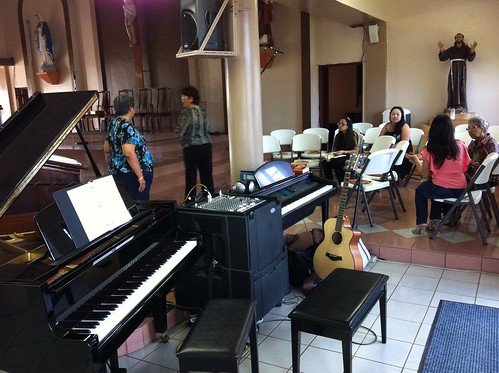 The choir chair positioning, we were actually able to fit in 3 more seats!  Thanks so much again! PS...The next step in the process is to measure the cable run which will feed the altar mix into the choir mix to add the same clarity into the church when the Priest speaks to the congregation. I feel very confident now of how to approach this using the lessons you've taught me (one change, test, one change test, etc.) and the sound engineering principles. Cheers from Guam! ... Joe |
|
#133
|
|||
|
|||
|
Well Joe,
It looks like we've accomplished our mission. I'm delighted to hear that everything worked out so well. The fact that you didn't have to spend any extra money, makes it doubly rewarding, and, you've now got surplus "gear in the bank" for future expansion. I'm so happy to hear that the piano is finally being incorporated into the mix, for the first time. You've done a great job Joe, and you've been a terrific partner throughout this project. I also get the impression that the priest and the choir are enthusiastic over the changes,,, and that's simply wonderful. This positive energy will fuel the congregations' appreciation, and in return, that should stimulate your performers even more. Beautiful. Joe, I hope you'll keep in touch. There are a few questions which were never cleared up in the thread, such as whether the choir stands while singing. I see room for possible improvements , but if you're happy with the status quo, we can leave it there for now. As for running the priests' mics through your system, this may not be such a good idea. We never cleared up what his system is,,,, whether it's a 70 volt distribution system, which is what I suspect it is, based on the number of speakers he has. His system would most likely be optimized for "speech", and the high number of loudspeakers would most likely perform better at handling the natural rise and fall of his voice. All in all Joe, it's been a very interesting project, and I thank you for allowing me to participate. Maybe one day, we'll see a Youtube video of your choir performing?????  Thank you so much for the pictures you've PM'd me, and I'm hoping you'll get a pic of that choir. I'd like to frame those pics, and put them in my studio. Thank you so much for the pictures you've PM'd me, and I'm hoping you'll get a pic of that choir. I'd like to frame those pics, and put them in my studio.Thanks again, Bob |
|
#134
|
|||
|
|||
|
[QUOTE=Bobby1note;3395867]Bob,
Joe, I hope you'll keep in touch. There are a few questions which were never cleared up in the thread, such as whether the choir stands while singing. I see room for possible improvements , but if you're happy with the status quo, we can leave it there for now. The choir stands while singing - for every song. The chairs are there for rests in between songs. With that being said, during a funeral this past Saturday, we added a dynamic mic (position behind the clavinova) for a soloist performance. The choir came in as backup during the refrain of the song - BUT THEY REMAINED SEATED. The condenser mic position or seating did not change (it was positioned for their standing position), however, it STILL SOUNDED GREAT! Because I wanted to see how this came through the PA at the back of the church, I leveled the mix during the first verse of the song, ran to the back of the church and listened carefully - it was still AMAZING when the choir sang the refrain while seated. The condenser, properly EQ and level set, its very sufficient for our needs. As for running the priests' mics through your system, this may not be such a good idea. We never cleared up what his system is,,,, whether it's a 70 volt distribution system, which is what I suspect it is, based on the number of speakers he has. His system would most likely be optimized for "speech", and the high number of loudspeakers would most likely perform better at handling the natural rise and fall of his voice. This is what I'd like to address next - and of course I'd love your recommendation. My apologies as I have not had a chance to photo the equipment for the altar mics. All I know is the mixer board is the exact same model as the choir's (Mackie CFX14) but there's an amplifier that's pushing the signal out to the 7 satellite speakers - they're not self-powered like the Mackie SRM450's. Should we continue this discussion on this thread or start another specifically referencing "Dual sound mixes in a single room"...or something like that? Let me know what you suggest. All in all Joe, it's been a very interesting project, and I thank you for allowing me to participate. Maybe one day, we'll see a Youtube video of your choir performing?????  Thank you so much for the pictures you've PM'd me, and I'm hoping you'll get a pic of that choir. I'd like to frame those pics, and put them in my studio. Thank you so much for the pictures you've PM'd me, and I'm hoping you'll get a pic of that choir. I'd like to frame those pics, and put them in my studio.I'm working on the pictures and the recording! Promise! Thanks again, and we're truly grateful for you and all your help! ... Joe |
|
#135
|
|||
|
|||
|
Joe,
My apologies,,, I had not seen your last post. Sorry for the late response. As for starting another thread, I'm not sure if anyone else is still interested in this thread. If so, let us know, and we can continue here, or, whatever you prefer, Joe. |
 |
|
| Tags |
| choir, church, condenser microphone, president's day sale |
|
|